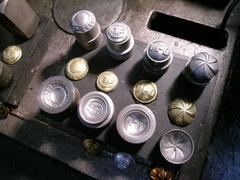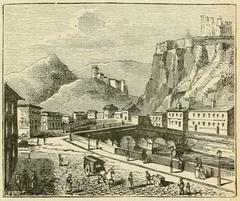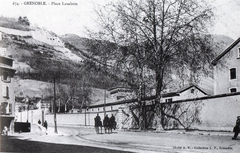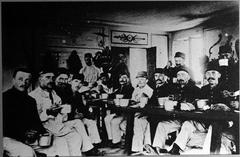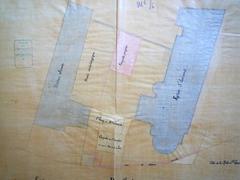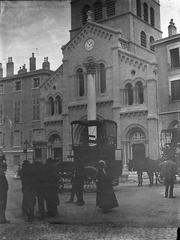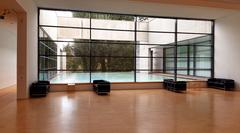Le Mercure Building Grenoble: Visiting Hours, Tickets, and Historical Significance
Date: 03/07/2025
Introduction
Nestled in the vibrant heart of Grenoble, France, the Le Mercure Building—understood to include several Mercure-branded hotels and a notable residential tower—stands as a testament to the city’s post-war modernization and ongoing embrace of sustainable urban living. Whether referenced as the Mercure Grenoble Centre Alpotel, Centre Président, or the iconic “Tour Mercure,” these structures encapsulate Grenoble’s transformation since the 1960s and provide visitors with a unique blend of modern comfort, architectural heritage, and proximity to cultural landmarks (Mercure Grenoble Centre Alpotel; Grenoble Tourisme).
This guide offers comprehensive visitor information, including opening hours, access policies, architectural highlights, nearby attractions, practical travel tips, and sustainability efforts. Whether you’re an architecture enthusiast, a history buff, or a traveler seeking eco-friendly experiences, Le Mercure serves as both a gateway and vantage point to explore Grenoble’s rich Alpine landscape.
Contents
- Introduction
- Visiting Information
- Opening Hours and Access
- Tickets and Events
- Photographic Highlights
- Historical and Architectural Significance
- Urban Evolution and Modernist Legacy
- Notable Design Features and Renovations
- Integration with Urban Fabric
- Practical Visitor Details
- Location and Transport
- Facilities and Services
- Booking and Contact
- Travel Tips
- Nearby Cultural and Architectural Attractions
- Commitment to Sustainability
- Frequently Asked Questions (FAQs)
- Visual and Interactive Resources
- Conclusion
Visiting Information
Opening Hours and Access
- Hotels (Mercure Grenoble Centre Alpotel & Président): Open 24/7 for guests.
- Public Spaces: Café Pourpre, restaurants, and lounges typically welcome non-guests between 7:00 AM and 10:00–11:00 PM.
- Le Mercure Residential Tower: Primarily a residential building; interior access is not available to the public. Only exterior viewing and photography from public spaces are permitted (Le Dauphiné).
Tickets and Events
- Admission: No ticket is required to enter public areas of the hotels. Special events or private functions may require registration; check the official websites for details.
- Guided Tours: Not regularly offered for the Mercure buildings themselves, but guided walks exploring Grenoble’s modernist architecture are available through local tourism offices (Grenoble Alpes Tourisme).
Photographic Highlights
- Hotel Terraces: Panoramic views of the Alps and Grenoble cityscape.
- Façades: Notable for clean, modernist lines and use of concrete and glass—excellent for architecture photography.
- Nearby Landmarks: Capture the Bastille Fortress, Place Grenette, and local street scenes.
Historical and Architectural Significance
Urban Evolution and Modernist Legacy
Le Mercure Building(s) emerged from Grenoble’s ambitious modernization tied to the 1968 Winter Olympics. This era catalyzed a wave of new construction reflecting optimism, innovation, and the integration of international visitors into the urban core (Grenoble City History). The post-war boom and Olympic legacy inspired new approaches to hospitality, commerce, and city planning (Urban Design Lab).
Notable Design Features and Renovations
- Mercure Grenoble Centre Alpotel & Président: Both feature late 20th-century French hotel design, characterized by functional layouts, Alpine-inspired décor, and use of modern materials. Recent renovations prioritize sustainability, accessibility, and contemporary comfort (Mercure Grenoble Centre Alpotel Renovation).
- Tour Mercure (Residential Tower): Once celebrated as a striking modernist landmark, it now faces challenges of aging infrastructure, with visible deterioration and ongoing safety measures such as façade nets (Le Dauphiné).
Integration with Urban Fabric
Strategically located near transport hubs and major boulevards, the Mercure buildings bridge the historic city center and newer districts. They exemplify the UNESCO concept of a “historic urban landscape,” blending new architecture with Grenoble’s cultural and natural assets (UNESCO 2011 Recommendation; Alpes Isère).
Practical Visitor Details
Location and Transport
- Mercure Grenoble Centre Alpotel: 12 Boulevard Maréchal Joffre, 38000 Grenoble (Mercure Grenoble Centre Alpotel)
- Mercure Grenoble Centre Président: 11 Rue Général Mangin, 38100 Grenoble (Mercure Grenoble Centre Président)
- Tour Mercure: 6 Rue Colonel-Dumont, 38000 Grenoble
- Nearby Public Transport: Chavant-Hôtel de Ville and Albert I de Belgique bus stops (2 min walk); Grenoble train station (approx. 2 km, accessible by tram/bus)
- Parking: On-site hotel parking; public garages nearby
Facilities and Services
- Accommodation: Comfortable guest rooms and suites, many with mountain views
- Dining: Regional specialties at Café Pourpre and other on-site restaurants
- Meeting & Event Spaces: Modular rooms with modern AV tech
- Wellness: Fitness centers, indoor pools, spa/jacuzzi at Centre Président
- Accessibility: Wheelchair-accessible rooms and public spaces
- Sustainability: Clef Verte (Green Key) certification; energy-efficient systems; local and organic food sourcing
Booking and Contact
- Mercure Grenoble Centre Alpotel: Official Website | Email: [email protected]
- Mercure Grenoble Centre Président: Official Website
Travel Tips
- Peak Periods: Book in advance during festivals, conferences, or ski season (France Travel Tips)
- Transport: Take advantage of Grenoble’s unified tram–bus ticketing and extensive bike infrastructure (That Adventurer)
- Sustainable Choices: Look for eco-certified hotels and responsible dining/shopping venues (Sustain Europe)
- Weather: Spring and early autumn offer the best climate; pack accordingly
Nearby Cultural and Architectural Attractions
- Bastille Fortress: Iconic mountain-top stronghold accessible by cable car (Bastille Fortress)
- Musée de Grenoble: Renowned for its fine art collection and modern design
- Les Halles Sainte-Claire: Historic market hall for food lovers (Les Halles Sainte-Claire)
- Jardin de Ville: A classic city park hosting cultural festivals
- Maison de la Culture (MC2): Landmark of modernist architecture and performing arts (Alpes Isère)
Commitment to Sustainability
Grenoble is a European Green Capital, recognized for leadership in sustainable tourism and urban living (Sustain Europe). Mercure hotels in Grenoble reflect this ethos with:
- Eco-friendly renovations and Clef Verte certification
- Energy-efficient lighting and water-saving technologies
- Waste reduction and food waste initiatives
- Support for local producers and responsible tourism practices
Visitors are encouraged to use public transport, rent bikes, dine at local eco-conscious restaurants, and support shops with “Green Commerce” labels.
Frequently Asked Questions (FAQs)
Q: Can I visit the interior of Le Mercure residential tower?
A: No, the residential tower is not open to the public. Only hotel public areas (lobbies, restaurants) are accessible.
Q: Are tickets required to visit Mercure hotels?
A: No ticket required for public areas. Special events may require registration.
Q: Are guided tours available?
A: Not for the Mercure buildings themselves, but architectural walking tours are available in the city (Grenoble Alpes Tourisme).
Q: Is the area accessible for visitors with disabilities?
A: Yes, the hotel facilities are fully accessible.
Q: What are sustainable travel tips for Grenoble?
A: Use public or eco-friendly transport, dine locally, minimize waste, and support responsible businesses (Sustain Europe).
Visual and Interactive Resources
- Virtual Tours & Photos: Explore high-resolution images and virtual tours on the Mercure Grenoble Centre Alpotel and Mercure Grenoble Centre Président websites.
- Maps and Itineraries: Downloadable city maps, public transport routes, and walking tours are available via Grenoble Alpes Tourisme.
Conclusion
Le Mercure Building in Grenoble is more than just a place to stay—it’s an important symbol of the city’s dynamic evolution, integrating modern architecture, hospitality, and urban sustainability. While interior access to the residential tower is restricted, the Mercure hotels offer comfort and connectivity to Grenoble’s rich heritage and Alpine scenery. Visitors can appreciate the building’s design, enjoy panoramic views, and explore nearby attractions, all while supporting Grenoble’s environmental initiatives.
For the latest updates, special offers, and curated travel tips, visit the official Mercure websites or download the Audiala app. Make your visit to Grenoble memorable by embracing its unique blend of history, innovation, and green living.
References and External Links
- Mercure Grenoble Centre Alpotel Renovation, 2024, Accor Hotels
- Grenoble City History, 2024, Grenoble Tourisme
- Le Mercure Grenoble: Visiting Hours, Hotel Info & Nearby Historical Sites, 2024, Grenoble Tourisme
- Urban Design Lab, 2023, The Role of Culture in Urban Design and Planning
- Alpes Isère: Grenoble & Its Architecture, 2024
- Sustain Europe: Grenoble European Green Capital 2022, 2023
- Le Dauphiné: Isère Grenoble L’Immeuble Le Mercure Un Joyau Architectural en Péril, 2024
- Mercure Grenoble Centre Président, 2024, Official Website
- Audiala App, 2025
- That Adventurer: Things to Do in Grenoble
- Nomads Travel Guide: Grenoble
- France Travel Tips
- Adventure Backpack: Grenoble Itinerary
- Les Halles Sainte-Claire
